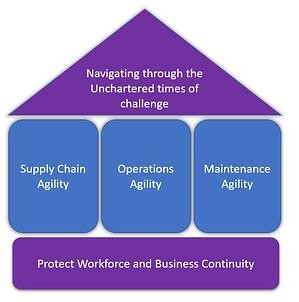How to navigate through uncharted times of challenge in oil and gas
Posted: April 27, 2020
One month ago, I do not think anybody could have imagined that crude sellers would pay $40 a barrel just to have somebody take oil off their hands.
The oil and gas industry has been hit very hard by the current pandemic. First, reduced demand due to global lockdown combined with oversupply has created a 20% imbalance, which caused the plunge in prices from +$60/bl to -$37/bl within weeks. Second, refiners are challenged with significant reductions in product demand, notably gasoline and jet fuel. This is forcing refineries to reduce throughput or temporary cease operations.
As companies move fast to manage supply, demand and pricing issues, a new challenge emerges: potential outbreaks of the pandemic. Closed working environments like FPSOs, oil rigs have potential cases of the virus, posing health hazards to workers and further disrupting operations.
Safety, Efficiency and Operations Continuity
According to a recent Accenture report, ‘ Enable Workforce and Supply Chain’ has been identified as one of the critical steps companies must take now to build resilience in this crisis. As safety, efficiency and operations continuity are becoming the top focused imperatives for most to sustain in the midst of chaos, digital transformation is even more important today than ever. Only with the right digital tools will successful companies manage the de-manning of production facilities while optimising the entire value chain.
Four key areas where Digital Transformation can enable oil and gas operations:

1) Protect Workforce and Operations continuity
Safety is always the top priority in oil and gas operations. Now, the biggest threat to workforce safety and operations continuity is proximity to co-workers. Connecting an agile but remote workforce to perform digitally-enabled tasks such as remote maintenance, engineering and operations is key to protecting teams’ safety and reducing risk of outbreaks. This is key to business continuity in today’s world. Reducing onsite operations teams has been a long-term goal in the industry. The de-manning priority has just been accelerated by the current crisis, we are excited to see how necessity today will transform operating models tomorrow.
2) Plan faster than a fast-changing market
The recent heightened volatility in crude and product prices and demand are making even the most current production planning and process models far from optimized. In addition to the demand uncertainty, process constraints due to IMO 2020 are creating more uncertainties in terms of feedstock availability and pricing. Making production choices today to optimize a plant can be a daunting task for most that could take days or even weeks to finalize the plans. A robust Supply Chain Management cloud platform combined with real-time crude management tools enables rapid modelling of refinery production planning that reduces business risks while improving collaboration between globally dispersed teams. The supply chain tools enable refiners to take advantage of economic opportunities and quickly react to market changes with fast optimization, built-in analytics and flexible reporting. Now, decisions that previously took two business days can be made in two hours.
3) Digital Agility forges Digital Resilience
End-to end value chain optimization helps redefine your processes, run what-scenarios, enable deeper collaboration, reduce value leaks, sustain productivity and innovation, and ultimately make better decisions quicker. Digital Agility enable operations to respond to changes in feedstocks and product specifications as well as process performance and constraints based on first principles simulation techniques to maximize profits. It uses real-time process and economic data to determine set points that guarantee maximum operating profit. Blending optimization systems and advanced process control ensure that all constraints and regulatory requirements are satisfied at minimum cost
4) The end of unplanned downtime
Companies may bring maintenance work turnarounds forward with declining demand due to the crisis. Keeping critical assets productive is becoming more challenging due to the changes in maintenance schedules and utilization in this heightened uncertainty period. Predictive Analytics enables hydrocarbon producers and refiners to not only remotely monitor asset health but also improve asset reliability by providing early warning notification and diagnosis of equipment issues days, weeks, or months before failure. This helps reduce equipment downtime, increase availability, and improve performance while reducing operations and maintenance expenditures.
Future state of oil and gas
Market rebalancing will take a while when the economy recovers. I can only imagine that a renewed oil and gas industry will emerge when the dust settles. One that is more agile and efficient, much more ready than before to tackle the next long-term structural challenge in sustainability.
In addition, download this IDC Whitepaper to understand how AVEVA can help oil and gas organizations build resiliency and adaptability in the face of disruption to make resilient decisions.
Related blog posts
Stay in the know: Keep up to date on the latest happenings around the industry.